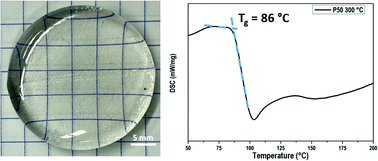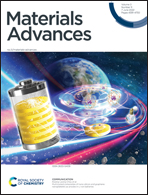Novel optical amorphous phosphate materials with a low melting temperature
Abstract
We report on the synthesis of transparent amorphous hydrated phosphate materials at low temperatures (as low as 300 °C) in the  (0–25 mol%). These new transparent materials were studied by Raman and FTIR spectroscopies. The structure of the hydrated phosphates is proposed to consist of both short phosphate chains and isolated phosphate groups linked together by hydrogen bonds. Containing up to 40 mol% of water, most of the physicochemical properties remain unchanged, except for the characteristic glass temperatures. Moreover, the most hydrated amorphous phosphate materials tend to exhibit a softening phenomenon below 150 °C. The addition of ZnO to these phosphate materials offers better glass stability against moisture while maintaining the glass properties of zinc-free materials. Hence, these new amorphous transparent materials pave the way for novel low melting temperature optical materials.
(0–25 mol%). These new transparent materials were studied by Raman and FTIR spectroscopies. The structure of the hydrated phosphates is proposed to consist of both short phosphate chains and isolated phosphate groups linked together by hydrogen bonds. Containing up to 40 mol% of water, most of the physicochemical properties remain unchanged, except for the characteristic glass temperatures. Moreover, the most hydrated amorphous phosphate materials tend to exhibit a softening phenomenon below 150 °C. The addition of ZnO to these phosphate materials offers better glass stability against moisture while maintaining the glass properties of zinc-free materials. Hence, these new amorphous transparent materials pave the way for novel low melting temperature optical materials.



 Please wait while we load your content...
Please wait while we load your content...